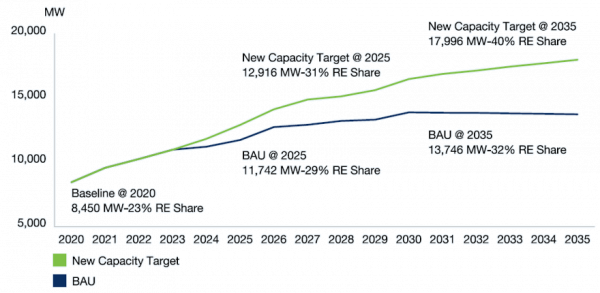
In 2021, the Ministry of Natural Resources, Environment and Climate Change (NRECC) set a target to reach 31% of RE share in the national installed capacity mix by 2025. This target supports Malaysia’s global climate commitment is to reduce its economy-wide carbon intensity (against GDP) of 45% in 2030 compared to 2005 level. Realization of the Government’s vision is crucial in supporting the nation to achieve its Nationally Determined Contributions (NDC) targets.
The Malaysia Renewable Energy Roadmap (MyRER) is commissioned to support further decarbonization of the electricity sector in Malaysia through the 2035 milestone. This is expected to drive a reduction in GHG emission in the power sector to support Malaysia in meeting its NDC 2030 target of 45% reduction in GHG emission intensity per unit of GDP in 2030 compared to the 2005 level, and further reduction of 60% in 2035.
The scope of MyRER includes three workstreams; assessing the baseline installed capacity and RE resources potential, developing technology-specific RE targets and scenarios, and developing a strategic roadmap.
The MyRER considers two distinct scenarios for RE development in the nation towards the 2025 Government committed RE target and through to the 2035 milestone:

The MyRER formulates strategies to achieve the Government’s committed target of 31% RE share in the national installed capacity mix and to further decarbonize the power generation sector until 2035 by maintaining affordability and system stability. To achieve the stipulated RE targets and aspirations, commitments by policy makers, industry players and strategic partners including financial institutions shall be the determinant in ensuring the successful implementation of this Roadmap. This Roadmap will optimize the socio-economic benefits from the development of RE in Malaysia, whilst positively contributing towards the global climate-change agenda in decarbonizing the power sector for a better future.
The Roadmap aims to strike a balance between environmental targets, preserve affordability and economic benefits, and maintain system stability by mitigating the impact of variable renewable energy (VRE) sources, ultimately enabling the Malaysia power sector to deliver reliable and affordable green power to all.

Data Collection & Synthesis
Capacity Planning
Development of Power Plants + Generation & sales of electricity
Malaysia is blessed with abundant RE resources readily exploitable for power generation due to:
1 year-round solar irradiation Agriculture, domestic and industrial waste for bioenergy combustion or gasification River basins for small hydroelectric power | Solar PV (includes ground mounted, rooftop and floating installation) |
 | Bioenergy (includes agriculture, animal and municipal & hazardous waste) |
 | Small hydro (system size up to 100 MW) |
 | Large hydro (system size > 100 MW) |
 | Geothermal |
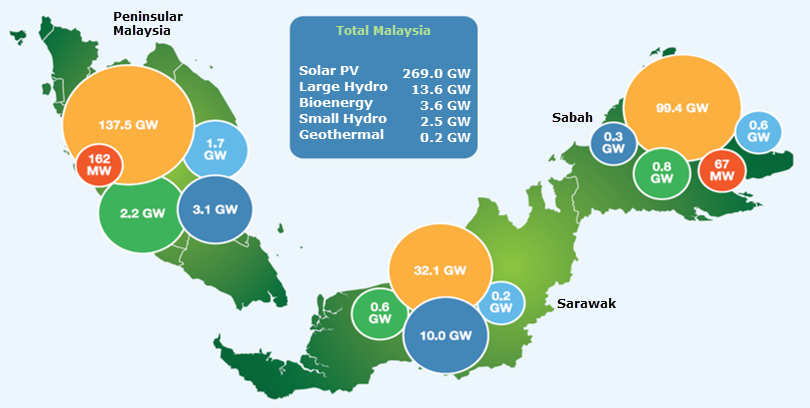
| SOLAR | LARGE HYDRO | BIOENERGY | SMALL HYDRO | GEOTHERMAL |
|---|---|---|---|---|
| 210GW Ground-mounted | 3.1GW Peninsular | 2.3GW Biomass | 1.7GW Peninsular | 162MW Peninsular |
| 42GW Rooftop | 500MW Sabah | 736MW Biogas | 0.6GW Sabah | 67MW Sabah |
| 17GW Floating | 10GW Sarawak | 516MW Solid Waste | 0.2GW Sarawak |
The MyRER 2035 considers two distinct scenarios for RE development in the nation toward the 2025 Government target and through to 2035:
Business as Usual (BAU)
Business as Usual (BAU) scenario considers the implementation of existing policies and programmes without further extension and/or introduction of new programmes.
New Capacity Target (NCT)
New Capacity Target scenario aims for much higher RE capacity target to align with further decarbonization of electricity sector in Malaysia toward 2035 milestone. This scenario is aligned with the capacity development plan of Planning and Implementation Committee for Electricity Supply and Tariff (JPPPET 2020) for Malaysia. It represents the official commitment by the Government in achieving the 31% and 40% RE target by 2025 and 2035 respectively.
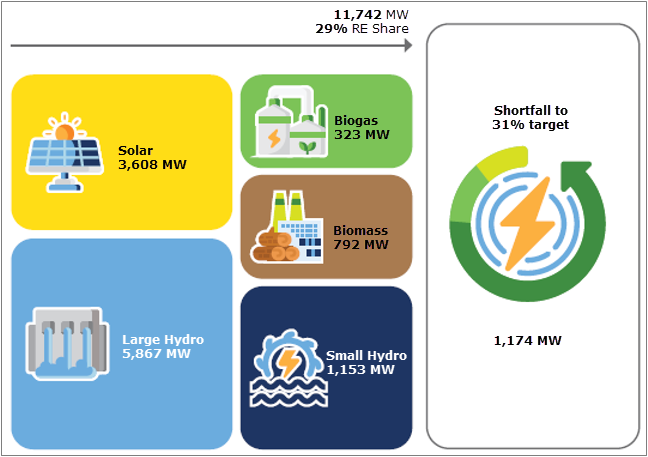

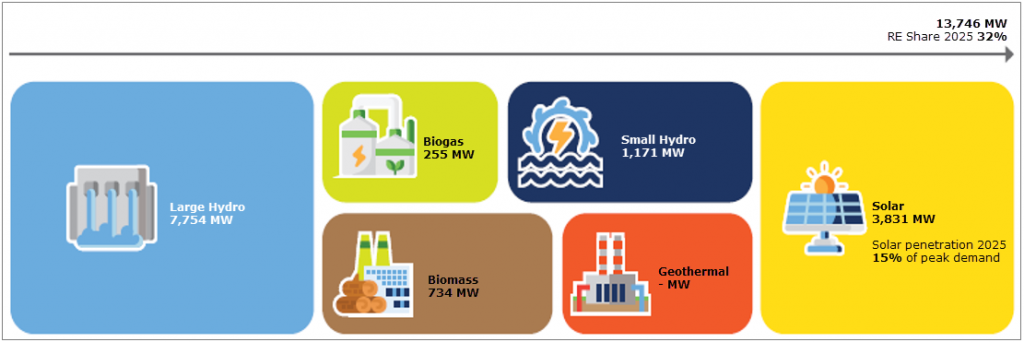

Updated as 6 October 2021
Figures inline with JPPET 2020
Source: SEDA; ST; SB Peninsular Malaysia, SB Sabah; SESB; SEB
The MyRER has been formulated to support Malaysia’s vision to achieve 31% RE share in the national installed capacity mix by 2025. Furthermore, the MyRER designs a pathway to enhance decarbonization of the electricity sector through 2035. The MyRER strategic framework builds upon 4 technology-specific pillars supported by 4 cross-technology enabling initiatives
Pathway Towards Low Carbon Energy System
Technology Specific Pillars
The Solar energy pillar is built upon existing programmes (i.e; NEM and LSS auctions) but to be complimented with the possibility of introducing new business models.
Accelerate Net Energy Metering (NEM)
New Business Models
Enhance LSS Auctions
Accelerate Net Energy Metering (NEM)
New Business Models
Enhance LSS Auctions
The Bioenergy pillar aims to increase bioenergy capacity by supporting the roll out of biomass, biogas and WTE capacity under the existing FiT via new business models (i.e; auctions and tendering programmes), as well as exploring potential opportunities in bio-CNG and biomass co-firing.
RE Fund (FiT)
New Business Models
Tender Waste-to-Energy Plant
Explore Other Opportunities
New Business Models
Tender Waste-to-Energy Plant
Explore Other Opportunities
The Hydro pillar supports accelerated deployment and operation of hydro generation capacity.
RE Fund (FiT)
Site identifications & Auctions
Auctioning of future capacity
Large Hydro potentials
RE Fund (FiT)
Site identifications & Auctions
Auctioning of future capacity
Large Hydro potentials
The new technology and solutions pillar support roll-out of new RE resources post 2025, as well as exploring solutions to maintain system stability under high VRE penetration.
Explore new RE resources
Roll-out of new solutions to ensure system stability
Explore new RE resources
Roll-out of new solutions to ensure system stability
There are four Enabling Initiatives supporting the implementation of the action plans for each strategic pillar.
Future-proofing electricity regulatory and market practices
Green Financing
Public awareness and readiness
System Flexibility
Energy transition phase has been identified as one of the main economic recovery post-pandemic.
The transition is expected to support direct and indirect jobs in the RE sector up to 2035 by: 46,636 job creations
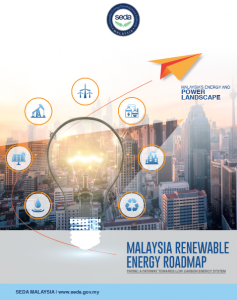
Want to know more?
– Click button below to have full access of MyRER 2035 Report
The MyRER document is an outcome of collective efforts by Ministry of Energy Transition and Water Transformation (PETRA), Sustainable Energy Development Authority (SEDA) Malaysia, together with industry stakeholders in formulating strategies to pave direction in realizing national renewable energy aspirations. The MyRER which is funded by Malaysia Electric Supply Industries Trust Account (MESITA) Fund, aims to catalyse the development of RE in Malaysia with the ultimate goal of delivering reliable green power to all.
PETRA and SEDA wish to thank the following organisations for their valuable contributions and inputs in completing this roadmap: the Economic Planning Unit (EPU), the Ministry of Plantation Industries and Commodities (MPIC), the Ministry of Housing and Local Government (MHLG), the Ministry of Utilities (MoU) Sarawak, State governments – Unit Perancang Ekonomi Negeri (UPEN), Suruhanjaya Tenaga (ST), Securities Commission (SC), Malaysian Investment Development Authority (MIDA), National Solid Waste Management Department (NSWMD), Malaysian Palm Oil Board (MPOB), Tenaga Nasional Berhad (TNB), Single Buyer (SB) of Peninsular Malaysia and Sabah, Grid System Operator (GSO), Sabah Electricity Sdn Bhd (SESB), Sarawak Energy Berhad (SEB), Malaysian Photovoltaic Industry Association (MPIA), Malaysia Small Hydro Industry Association (MASHIA), Malaysia Biomass Industries Confederation (MBIC), Biogas Association Malaysia, Malaysian Gas Association, RE industry players, and financial institutions.
PETRA and SEDA would also like to thank the experts from the Asian Development Bank (ADB) and the International Renewable Energy Agency (IRENA) for their peer reviews.